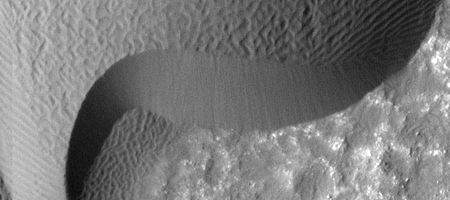NASA’s Mars Reconnaissance Orbiter (MRO) has revealed that sand dunes on Mars can put on a surprising turn of speed.

Indeed, they can move as fast as those on Earth – unexpectedly, as Mars has a much thinner atmosphere than Earth and is only about one percent as dense, with weaker winds.
It’s only in the last two years that scientists have determined that the dunes aren’t, as some thought, mostly fossil features related to past climate, rather than currently active.
But images from MRO’s High Resolution Imaging Science Experiment (HiRISE) camera have determined that entire dunes as thick as 200 feet are moving as coherent units.
“This exciting discovery will inform scientists trying to better understand the changing surface conditions of Mars on a more global scale,” sys Doug McCuistion, director of NASA’s Mars Exploration Program in Washington.
“This improved understanding of surface dynamics will provide vital information in planning future robotic and human Mars exploration missions.”
Researchers analyzed before-and-after images using a new software tool developed at Caltech which measures changes in the position of sand ripples, revealing that the ripples move faster the higher up they are on a dune.
Using the new information about the volume of sand that is moving, scientists estimate rocks in Nili Patera, the area studied, would be worn away at about the same pace as rocks near sand dunes in Antarctica, where similar sand fluxes occur.
“Our new data shows wind activity is indeed a major agent of evolution of the landscape on Mars,” says Jean-Philippe Avouac, Caltech team leader.
“This is important because it tells us something about the current state of Mars and how the planet is working today, geologically.”






